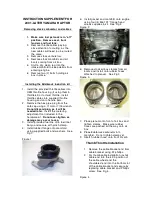
100
Chevrolet 2010 New Sail New Technical Training
- Learner's Manual
5.8
Anti-Lock Braking System
(
ABS
)
Warning Light
The anti-lock braking system warning light is mounted in the instrument cluster and is illuminated when the
electronic brake control module detects any malfunction in the anti-lock braking system. The anti-lock braking
system
(
ABS
)
warning light informs the driver that there is a malfunction resulting in the shut-down of the
anti-lock braking system. If only the anti-lock braking system warning light is illuminated, then normal braking
function with full brake assist will still work.
The conditions for activating the anti-lock braking system warning light are as follows:
z
As stated above, when a malfunction is found in the anti-lock braking system, the anti-lock braking
system warning light will be illuminated.
z
During a lamp test of the dashboard instrument cluster: the anti-lock braking system
(
ABS
)
warning
light will be illuminated approximately for 3 seconds and then go out when the ignition switch is closed.
5.9
Brake Warning Light
The red brake warning light in the instrument cluster is illuminated to warn the driver that there is a
(
are
)
malfunction condition
(
s
)
in the braking system and the braking effect is therefore reduced. When the hand brake
is pulled up, not completely loose, or the brake fluid level switch is closed
(
the switch will be closed when the
brake fluid level in the fluid storage tank of the Master Cylinder is too low
)
, the warning light will also be
illuminated. When the brake level switch is closed, the indicating fluid level is too low. At this point, the
malfunction
(
s
)
must be repaired, otherwise the brake warning light won't go out. Some malfunctions in the
MGH-25 system will also illuminate the warning light to inform the driver that the DDRP
(
decoupled dynamic
rear proportioning
)
is shut down.
5.10
Rear Drum Brake
The drum brake assembly employs the design of a leading trailing shoe brake. The two brake shoes are
firmly compressed on the brake wheel cylinder piston by the lower return spring and the fixed anchor plate next to
it. When the brake pedal is pressed, the brake wheel cylinder piston moves the two brake shoes outwards to allow
them to touch the brake drums. When wheels are advancing, the front brake shoes will stretch out inside the brake
drums and generate energizing effort. When wheels are reversing, the rear brake shoes will generate self
energizing effort. The force from the brake shoes is passed to the anchor plate, and then passed to the axle flange
through the bottom plate. Adjustment is automatically carried out, and it happens every time the brake pedal is
pressed. The positions of used shoe plates shall not be exchanged, otherwise the self-adjustment function will
disable and the pedal stroke will be increased.
Summary of Contents for Sail 2010
Page 14: ...10 Chevrolet 2010 New Sail New Technical Training Learner s Manual Spark Plug Type RA7YC ...
Page 31: ...27 Chevrolet 2010 New Sail New Technical Training Learner s Manual ...
Page 43: ...39 Chevrolet 2010 New Sail New Technical Training Learner s Manual ...
Page 45: ...41 Chevrolet 2010 New Sail New Technical Training Learner s Manual ...
Page 49: ...45 Chevrolet 2010 New Sail New Technical Training Learner s Manual ...
Page 57: ...53 Chevrolet 2010 New Sail New Technical Training Learner s Manual ...
Page 76: ...72 Chevrolet 2010 New Sail New Technical Training Learner s Manual 4 7 4 Horn Circuit Diagram ...
Page 92: ...88 Chevrolet 2010 New Sail New Technical Training Learner s Manual 4 7 20 Audio System ...
















































